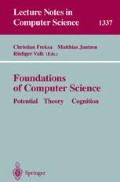Abstract
The structures of space and time are identified as essential for the realization of cognitive systems. It is suggested that the omnipresence of space and time may have been responsible for neglecting these dimensions in knowledge processing in the past. The evolving interest in space and time in cognitive science and some of the current conceptions of space and time are briefly reviewed. It is argued that space and time not only structure cognitive representations and processes but also provide useful information for knowledge processing. Various ways of structuring space and time are discussed and the merits of different languages for describing space and time are addressed. In particular, qualitative and quantitative descriptions are related to local and global reference frames and crisp qualities are related to fuzzy quantities. The importance of selecting an appropriate level of interpretation for a given description is stressed. Examples of interpreting spatial and temporal object descriptions in various ways are presented.
Support from the Deutsche Forschungsgemeinschaft is gratefully acknowledged.
Preview
Unable to display preview. Download preview PDF.
References
Andersen, R.A. 1987. Inferior parietal lobule function in spatial perception and visuomotor integration. In Handbook of physiology, The nervous system VI, Higher functions of the brain, part 2, ed. Plum, 483–518. Bethesda, Md.: American Physiological Society.
Freksa, C. 1980. Communication about visual patterns by means of fuzzy characterizations. Proc. XXIInd Intern. Congress of Psychology, Leipzig.
Freksa, C. 1991. Conceptual neighborhood and its role in temporal and spatial reasoning. In Decision Support Systems and Qualitative Reasoning, ed. Singh and Travé-Massuyès, 181–187. Amsterdam: North-Holland.
Freksa, C. 1994. Fuzzy systems in AI. In Fuzzy systems in computer science, ed. Kruse, Gebhardt, and Palm. Braunschweig/Wiesbaden: Vieweg.
Freksa, C., and Barkowsky, T., 1996. On the relation between spatial concepts and geographic objects. In Geographic objects with indeterminate boundaries, ed. Burrough and Frank, 109–121. London: Taylor and Francis.
Freksa, C., and Habel, C. 1990. Warum interessiert sich die Kognitionsforschung für die Darstellung räumlichen Wissens? In Repräsentation und Verarbeitung räumlichen Wissens, ed. Freksa and Habel, 1–15, Berlin: Springer-Verlag.
Habel, C. 1994. Discreteness, finiteness, and the structure of topological spaces. In Topological foundations of cognitive science, FISI-CS workshop Buffalo, NY, Report 37, ed. Eschenbach, Habel, and Smith, Hamburg: Graduiertenkolleg Kognitionswissenschaft.
Hayes, P. 1978. The naive physics manifesto. In Expert systems in the microelectronic age, ed. Michie. Edinburgh: Edinburgh University Press.
Landau, B. and Jackendoff, R. 1993. “What”' and “where” in spatial language and spatial cognition, Behavioral and Brain Sciences 16: 217–265.
Lynch, K. 1960. The image of the city. Cambridge, Mass.: The MIT Press.
Retz-Schmidt, G. 1988. Various views on spatial prepositions. AI Magazine, 4/88: 95–105.
Schlieder, C. 1996. Räumliches Schließen. In Wörterbuch der Kognitionswissenschaft, ed. Strube, Becker, Freksa, Hahn, Opwis, and Palm, 608–609. Stuttgart: Klett-Cotta.
Zadeh, L.A. 1978. Fuzzy sets as a basis for a theory of possibility. Fuzzy sets and systems 1, 3–28.
Zimmermann, K. 1995. Measuring without measures: the delta-calculus. In Spatial information theory. A theoretical basis for GIS, ed. Frank and Kuhn, 59–67. Berlin: Springer.
Author information
Authors and Affiliations
Editor information
Rights and permissions
Copyright information
© 1997 Springer-Verlag Berlin Heidelberg
About this chapter
Cite this chapter
Freksa, C. (1997). Spatial and temporal structures in cognitive processes. In: Freksa, C., Jantzen, M., Valk, R. (eds) Foundations of Computer Science. Lecture Notes in Computer Science, vol 1337. Springer, Berlin, Heidelberg. https://doi.org/10.1007/BFb0052106
Download citation
DOI: https://doi.org/10.1007/BFb0052106
Published:
Publisher Name: Springer, Berlin, Heidelberg
Print ISBN: 978-3-540-63746-2
Online ISBN: 978-3-540-69640-7
eBook Packages: Springer Book Archive

